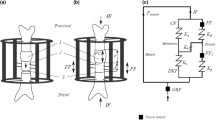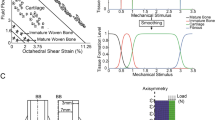Abstract
In tensional studies of bone fragments during limb lengthening, it is usually assumed that the stress level in the gap tissue before each distraction step (pre-traction stress) is rather modest. However, during the process of distraction osteogenesis, a large interfragmentary gap is generated and these pre-traction stresses may be important. To date, to the authors’ knowledge, no computational study has been developed to assess the effect of stress accumulation during limb lengthening. In this work, we present a macroscopic growth mixture formulation to investigate the influence of pre-traction stresses on the outcome of this clinical procedure. In particular, the model is applied to the simulation of the regeneration of tibial defects by means of distraction osteogenesis. The evolution of pre-traction forces, post-traction forces and peak forces is evaluated and compared with experimental data. The results show that the inclusion of pre-traction stresses in the model affects the evolution of the regeneration process and the corresponding reaction forces.
Similar content being viewed by others
References
Aarnes GT, Steen H, Kristiansen LP, Ludvigsen P, Reikerås O (2002) Tissue response during monofocal and bifocal leg lengthening in patients. J Orthop Res 20: 137–141
Akizuki S, Mow VC, Müller F, Pita JC, Howell DS, Manicourt DH (1986) Tensile properties of human knee joint cartilage: I. influence of ionic conditions, weight bearing, and fibrillation on the tensile modulus. J Orthop Res 4: 379–392
Alastrué V, Peña E, Martínez MA, Doblaré M (2007) Assessing the use of the “opening angle method” to enforce residual stresses in patient-specific arteries. Ann Biomed Eng 35: 1821–1837
Armstrong CG, Mow VC (1982) Variations in the intrinsic mechanical properties of human articular cartilage with age, degeneration, and water content. J Bone Joint Surg Am 64: 88–94
Bailón-Plaza A, van der Meulen MC (2003) Beneficial effects of moderate, early loading and adverse effects of delayed or excessive loading on bone healing. J Biomech 36: 1069–1077
Bertram JE, Polevoy Y, Cullinane DM (1998) Mechanics of avian fibrous periosteum: tensile and adhesion properties during growth. Bone 22: 669–675
Boccaccio A, Pappalettere C, Kelly DJ (2007) The influence of expansion rates on mandibular distraction osteogenesis: a computational analysis. Ann Biomed Eng 35: 1940–1960
Breward CJ, Byrne HM, Lewis CE (2003) A multiphase model describing vascular tumour growth. Bull Math Biol 65: 609–640
Brunner UH, Cordey J, Schweiberer L, Perren SM (1994) Force required for bone segment transport in the treatment of large bone defects using medullary nail fixation. Clin Orthop Relat Res 301: 147–155
Carter DR, Beaupre GS, Giori NJ, Helms JA (1998) Mechanobiology of skeletal regeneration. Clin Orthop Relat Res 355S: S41–S55
Charlebois M, McKee MD, Buschmann MD (2004) Nonlinear tensile properties of bovine articular cartilage and their variation with age and depth. J Biomech Eng 126: 129–137
Chen Y, Hoger A (2000) Constitutive functions for elastic materials in finite growth and deformation. J Elast 59: 175–193
Chuong CJ, Fung YC (1986) On residual stresses in arteries. J Biomech Eng 108: 189–192
Claes LE, Heigele CA (1999) Magnitudes of local stress and strain along bony surfaces predict the course and type of fracture healing. J Biomech 32: 255–266
Davol A, Bingham MS, Sah RL, Klisch SM (2008) A nonlinear finite element model of cartilage growth. Biomech Model Mechanobiol 7: 295–307
DiCarlo A, Quiligotti S (2002) Growth and balance. Mech Res Commun 29: 449–456
Doblaré M, García-Aznar JM (2006) On numerical modelling of growth, differentiation and damage in structural living tissues. Arch Comput Methods Eng 13: 471–513
Epstein M, Maugin GA (2000) Thermomechanics of volumetric growth in uniform bodies. Int J Plast 16: 951–978
Forriol F, Goenaga I, Mora G, Viñolas J, Canadell J (1997) Measurement of bone lengthening forces; an experimental model in the lamb. Clin Biomech 12: 17–21
Fung YC (1984) Biodynamics: circulation. Springer, New York
Fung YC (1985) What principle governs the stress distribution in living organs? In: Fung YC, Fukada E, Wang JJ (eds) Biomechanics in China, Japan, and USA. Science Press, Beijing, pp 1–13
Fung YC (1990a) Biomechanics: motion, flow, stress, and growth. Springer, New York
Fung YC (1990b) Biomechanics: mechanical properties of living tissues. Springer, Berlin
García-Aznar JM, Kuiper JH, Gómez-Benito MJ, Doblaré M, Richardson JB (2007) Computational simulation of fracture healing: influence of interfragmentary movement on the callus growth. J Biomech 40: 1467–1476
Gardner TN, Evans M, Simpson H, Kenwright J (1998) Force–displacement behaviour of biological tissue during distraction osteogenesis. Med Eng Phys 20: 708–715
Garikipati K, Arruda EM, Grosh K, Narayanan H, Calve S (2004) A continuum treatment of growth in biological tissue: the coupling of mass transport and mechanics. J Mech Phys Solids 52: 1595–1625
Gómez-Benito MJ, García-Aznar JM, Kuiper JH, Doblaré M (2005) Influence of fracture gap size on the pattern of long bone healing: a computational study. J Theor Biol 235: 105–119
Gómez-Benito MJ, García-Aznar JM, Kuiper JH, Doblaré M (2006) A 3d computational simulation of fracture callus formation: influence of the stiffness of the external fixator. J Biomech Eng 128: 290–299
Gregersen H, Kassab GS, Fung YC (2000) The zero stress state of the gastrointestinal tract: biomechanical and functional implications. Dig Dis Sci 45: 2271–2281
Han HC, Fung YC (1996) Direct measurement of transverse residual strains in aorta. Am J Physiol 270: H750–H759
Hibbit K, Sorensen I (2008) Theory manual, vol 6.8. HKS inc, Pawtucket
Himpel G, Kuhl E, Menzel A, Steinmann P (2005) Computational modelling of isotropic multiplicative growth. Comput Model Eng Sci 8: 119–134
Hoger A (1997) Virtual configurations and constitutive equations for residually stressed bodies with material symmetry. J Elast 48: 125–144
Hori RY, Lewis JL (1982) Mechanical properties of the fibrous tissue found at the bone-cement interface following total joint replacement. J Biomed Mater Res 16: 911–927
Huang CY, Mow VC, Ateshian GA (2001) The role of flow-independent viscoelasticity in the biphasic tensile and compressive responses of articular cartilage. J Biomech Eng 123: 410–417
Huang Z (1994) The equilibrium equations and constitutive equations of the growing deformable body in the framework of continuum theory. Int J Non-Linear Mech 39: 951–962
Humphrey JD (2001) Stress, strain, and mechanotransduction in cells. J Biomech Eng 123: 638–641
Humphrey JD, Rajagopal KR (2003) A constrained mixture model for arterial adaptations to a sustained step change in blood flow. Biomech Model Mechanobiol 2: 109–126
Isaksson H, Comas O, van Donkelaar CC, Mediavilla J, Wilson W, Huiskes R, Ito K (2007) Bone regeneration during distraction osteogenesis: mechano-regulation by shear strain and fluid velocity. J Biomech 40: 2002–2011
Isaksson H, Wilson W, van Donkelaar CC, Huiskes R, Ito K (2006) Comparison of biophysical stimuli for mechano-regulation of tissue differentiation during fracture healing. J Biomech 39: 1507–1516
Klisch SM, Chen SS, Sah RL, Hoger A (2003) A growth mixture theory for cartilage with application to growth-related experiments on cartilage explants. J Biomech Eng 125: 169–179
Klisch SM, Sah RL, Hoger A (2005) A cartilage growth mixture model for infinitesimal strains: solutions of boundary-value problems related to in vitro growth experiments. Biomech Model Mechanobiol 3: 209–223
Klisch SM, Van Dyke TJ, Hoger A (2001) A theory of volumetric growth for compressible elastic biological materials. Math Mech Solids 6: 551–575
Kuhl E, Menzel A, Steinmann P (2003) Computational modeling of growth. Comput Mech 32: 71–88
Kuhl E, Steinmann P (2003) Mass- and volumetric-specific views on thermodynamics for open systems. Proc R Soc London 459A: 2547–2568
Lacroix D, Prendergast PJ (2002) A mechano-regulation model for tissue differentiation during fracture healing: analysis of gap size and loading. J Biomech 35: 1163–1171
Lappa M (2005) A CFD level-set method for soft tissue growth: theory and fundamental equations. J Biomech 38: 185–190
Leong JC, Ma RY, Clark JA, Cornish LS, Yau AC (1979) Viscoelastic behavior of tissue in leg lengthening by distraction. Clin Orthop Relat Res 139: 102–109
Leong PL, Morgan EF (2008) Measurement of fracture callus material properties via nanoindentation. Acta Biomater 4: 1569–1575
Levick JR (1987) Flow through interstitium and other fibrous matrices. Q J Exp Physiol 72: 409–438
Li G, Bronk JT, An KN, Kelly PJ (1987) Permeability of cortical bone of canine tibiae. Microvasc Res 34: 302–310
Li G, Simpson HRW, Kenwright J, Triffitt JT (1997) Assessment of cell proliferation in regenerating bone during distraction osteogenesis at different distraction rates. J Orthop Res 15: 765–772
Liu SQ, Fung YC (1988) Zero-stress states of arteries. J Biomech Eng 110: 82–84
Lubarda VA, Hoger A (2002) On the mechanics of solids with a growing mass. Int J Solids Struct 39: 4627–4664
Matsushita T, Nakamura K, Kurokawa T (1999) Tensile force in limb lengthening: histogenesis or only mechanical elongation. Orthopedics 22: 61–63
Menzel A (2005) Modelling of anisotropic growth in biological tissues. A new approach and computational aspects. Biomech Model Mechanobiol 3: 147–171
Menzel A (2006) Anisotropic remodeling of biological tissue. In: Holzapfel, Ogden (eds) Mechanics of biological tissue. Springer, Berlin, pp 91–104
Nafei A, Danielsen C, Linde F, Hvid I (2000) Properties of growing trabecular ovine bone. Part I: mechanical and physical properties. J Bone Joint Surg Br 82: 910–920
Nakamura K, Matsushita T, Okazaki H, Kurokawa T (1997) Soft tissue responses to limb lengthening. J Orthop Sci 2: 191–197
Ochoa JA, Hillberry BM (1992) Permeability of bovine cancellous bone. In: Transactions of the 38th ORS, Washinton, DC
Pauwels F (1960) Eine neue Theorie über den Einfluβ mechanischer Reize auf die Differenzierung der Stützgewebe. Z Anat Entwicklungsgesch 121: 478–515
Perren SM, Cordey J (1980) The concept of interfragmentary strain. Currect concepts of internal fixation of fractures. Springer, Berlin, pp 63–77
Popowics T, Zhu Z, Herring S (2002) Mechanical properties of the periosteum in the pig, sus scrofa. Arch Oral Biol 47: 733–741
Preziosi L, Farina A (2002) On Darcy’s law for growing porous media. Int J Non-Linear Mech 37: 485–491
Quiligotti S (2002) On bulk growth mechanics of solid-fluid mixtures: kinematics and invariance requirements. Theor Appl Mech 28(29): 277–288
Ramasubramanian A, Taber LA (2008) Computational modeling of morphogenesis regulated by mechanical feedback. Biomech Model Mechanobiol 7: 77–91
Reina-Romo E, Gómez-Benito MJ, García-Aznar JM, Domínguez J, Doblaré M (2009) Modeling distraction osteogenesis: analysis of the distraction rate. Biomech Model Mechanobiol. doi:10.1007/s10237-008-0138-x
Richards M, Wineman AS, Alsberg E, Goulet JA, Goldstein SA (1999) Viscoelastic characterization of mesenchymal gap tissue and consequences for tension accumulation during distraction. J Biomech Eng 121: 116–123
Rodriguez EK, Hoger A, McCulloch AD (1994) Stress-dependent finite growth in soft elastic tissues. J Biomech 27: 455–467
Simpson AH, Cunningham JL, Kenwright J (1996) The forces which develop in the tissues during leg lengthening. A clinical study. J Bone Joint Surg Br 78: 979–983
Skalak R (1981) Growth as a finite displacement field. In: Carlson DE, Shield RT (eds) Proceedings of IUTAM symposium on finite elasticity. Martinus Nijhoff, The Hague, pp 347–355
Skalak R, Dasgupta G, Moss M, Otten E, Dullumeijer P, Vilmann H (1982) Analytical description of growth. J Theor Biol 94: 555–577
Taber LA (1998) A model for aortic growth based on fluid shear and fiber stresses. J Biomech Eng 120: 348–354
Taber LA, Eggers DW (1996) Theoretical study of stress-modulated growth in the aorta. J Theor Biol 180: 343–357
Taber LA, Humphrey JD (2001) Stress-modulated growth, residual stress, and vascular heterogeneity. J Biomech Eng 123: 528–535
Taber LA, Perucchio R (2000) Modeling heart development. J Elast 61: 165–197
Vaishnav RN, Vossoughi J (1983) Estimation of residual strain in aortic segments. In: Hall CW (eds) Biomedical engineering II: recent development. Pergamon Press, Oxford, , pp 330–333
Vaishnav RN, Vossoughi J (1987) Residual stress and strain in aortic segments. J Biomech 20: 235–239
Volokh KY (2004) A simple phenomenological theory of tissue growth. Mech Chem Biosyst 1: 147–160
Waanders NA, Richards M, Steen H, Kuhn JL, Goldstein SA, Goulet JA (1998) Evaluation of the mechanical environment during distraction osteogenesis. Clin Orthop Relat Res 349: 225–234
Author information
Authors and Affiliations
Corresponding author
Rights and permissions
About this article
Cite this article
Reina-Romo, E., Gómez-Benito, M.J., García-Aznar, J.M. et al. Growth mixture model of distraction osteogenesis: effect of pre-traction stresses. Biomech Model Mechanobiol 9, 103–115 (2010). https://doi.org/10.1007/s10237-009-0162-5
Received:
Accepted:
Published:
Issue Date:
DOI: https://doi.org/10.1007/s10237-009-0162-5




